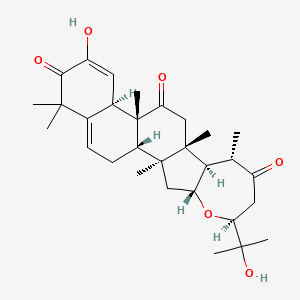| Authors | Title | Published | Journal | PubMed Link |
|---|---|---|---|---|
| Yang PQ et al. | Cucurbitacin contents in Hemsleya dolichocarpa. | 1991 | Am. J. Chin. Med. | pmid:1897490 |
| Chen X et al. | Biological activities and potential molecular targets of cucurbitacins: a focus on cancer. | 2012 | Anticancer Drugs | pmid:22561419 |
| Henrich CJ et al. | Effects of cucurbitacins on cell morphology are associated with sensitization of renal carcinoma cells to TRAIL-induced apoptosis. | 2012 | Apoptosis | pmid:21928090 |
| Tannin-Spitz T et al. | Cucurbitacin glucosides: antioxidant and free-radical scavenging activities. | 2007 | Biochem. Biophys. Res. Commun. | pmid:17942079 |
| Witkowski A et al. | Inhibition of the biosynthesis of deoxyribonucleic acid, ribonucleic acid and protein in HeLa S3 cells by cucurbitacins, glucocorticoid-like cytotoxic triterpenes. | 1984 | Biochem. Pharmacol. | pmid:6546879 |
| Witkowski A and Konopa J | Binding of the cytotoxic and antitumor triterpenes, cucurbitacins, to glucocorticoid receptors of HeLa cells. | 1981 | Biochim. Biophys. Acta | pmid:6894552 |
| Patel SK et al. | Roles of nonpolar and polar intermolecular interactions in the improvement of the drug loading capacity of PEO-b-PCL with increasing PCL content for two hydrophobic Cucurbitacin drugs. | 2009 | Biomacromolecules | pmid:19655789 |
| Patel SK et al. | Prediction of the solubility of cucurbitacin drugs in self-associating poly(ethylene oxide)-b-poly(alpha-benzyl carboxylate epsilon-caprolactone) block copolymer with different tacticities using molecular dynamics simulation. | 2010 | Biomaterials | pmid:19796808 |
| Patel SK et al. | Molecular dynamics study of the encapsulation capability of a PCL-PEO based block copolymer for hydrophobic drugs with different spatial distributions of hydrogen bond donors and acceptors. | 2010 | Biomaterials | pmid:19962756 |
| Bai M et al. | Development and validation of an LC-ESI-MS/MS method for the quantitation of hemslecin A in rhesus monkey plasma and its application in pharmacokinetics. | 2014 | Biomed. Chromatogr. | pmid:24132644 |
Cucurbitacin S
Cucurbitacin s is a lipid of Sterol Lipids (ST) class. The involved functions are known as establishment and maintenance of localization and nitric oxide biosynthetic process.
Cross Reference
Introduction
To understand associated biological information of Cucurbitacin S, we collected biological information of abnormalities, associated pathways, cellular/molecular locations, biological functions, related genes/proteins, lipids and common seen animal/experimental models with organized paragraphs from literatures.
What diseases are associated with Cucurbitacin S?
There are no associated biomedical information in the current reference collection.
No disease MeSH terms mapped to the current reference collection.
PubChem Associated disorders and diseases
What pathways are associated with Cucurbitacin S
There are no associated biomedical information in the current reference collection.
PubChem Biomolecular Interactions and Pathways
Link to PubChem Biomolecular Interactions and PathwaysWhat cellular locations are associated with Cucurbitacin S?
There are no associated biomedical information in the current reference collection.
What functions are associated with Cucurbitacin S?
Related references are published most in these journals:
| Function | Cross reference | Weighted score | Related literatures |
|---|
What lipids are associated with Cucurbitacin S?
There are no associated biomedical information in the current reference collection.
What genes are associated with Cucurbitacin S?
There are no associated biomedical information in the current reference collection.
What common seen animal models are associated with Cucurbitacin S?
There are no associated biomedical information in the current reference collection.
